
The Dublin Area Rapid Transit system is an electrified commuter rail railway network serving the coastline and city of Dublin, Ireland. The service makes up the core of Dublin's suburban railway network, stretching from Greystones, County Wicklow, in the south to Howth and Malahide in north County Dublin. The DART serves 31 stations and consists of 53 route kilometres of electrified railway, and carries in the region of 20 million passengers per year. In a similar manner to the Berlin S-Bahn, the DART blends elements of a commuter rail service and a rapid transit system.

Luas is a tram system in Dublin, Ireland. There are two main lines: the Green Line, which began operating on 30 June 2004, and the Red Line which opened on 26 September 2004. Since then, the red line has been extended and split into different branches further out of the city and the green line has been extended north and south as a single line. Since the northern extension of the green line in 2017, the two lines intersect in the city centre. The system now has 67 stops and 42.5 kilometres (26.4 mi) of revenue track, which in 2023 carried 48.2 million passengers, an increase of 24% compared to 2022.

Heuston Station, also known as Dublin Heuston, is one of Dublin's largest railway stations and links the capital with the south, southwest and west of Ireland. It is operated by Iarnród Éireann (IÉ), the national railway operator. It also houses the head office of its parent company, Córas Iompair Éireann (CIÉ). The station is named in honour of Seán Heuston, an executed leader of the 1916 Easter Rising, who had worked in the station's offices.
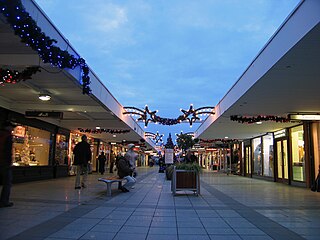
Stillorgan, formerly a village in its own right, is now a suburban area of Dublin in Ireland. Stillorgan is located in Dún Laoghaire–Rathdown, and contains many housing estates, shops and other facilities, with the old village centre still present. Stillorgan is at least partly contiguous with Kilmacud and neighbours other southside districts such as Mount Merrion, Sandyford, Leopardstown, Dundrum, Blackrock, Goatstown and Foxrock.

Dundrum, originally a village in its own right, is an outer suburb of Dublin, Ireland. The area is located in the postal districts of Dublin 14 and Dublin 16. Dundrum is home to the Dundrum Town Centre, the largest shopping centre in Ireland.

The Railway Procurement Agency was a state agency of the Department of Transport, Tourism and Sport in the Republic of Ireland, charged with the development of light railway and the future metro infrastructure.

Tara Street is a railway station in central Dublin, Ireland. It is adjacent to the Loopline Bridge on George's Quay.

The Square Tallaght is a shopping centre located in Tallaght, Dublin, Ireland, opened in 1990. It is located 10 minutes from junction 11 of the M50 motorway on the Belgard Road and the N81.

Transport 21 was an Irish infrastructure plan, announced in November 2005. Its aims were to greatly expand Ireland's transport network. A cost estimate of €34 billion was attached to the plan at the time.

The Red Line is one of the two lines of Dublin's Luas light rail system. The Red Line runs in an east–west direction through the city centre, north of the River Liffey, before travelling southwest to Tallaght, with a fork to Citywest and Saggart. The Red Line opened on 26 September 2004.

The Green Line is one of the two lines of Dublin's Luas light rail system. The Green Line was formerly entirely in the south side of Dublin city. It mostly follows the route of the old Harcourt Street railway line, which was reserved for possible re-use when it closed in 1958. The Green Line allows for passengers to transfer at O’ Connell GPO and Marlborough to Luas Red Line services and also allows commuters to use Broombridge as an interchange station to reach outer suburbs such as Castleknock and Ongar as well as Iarnrod Éireann services.
DART Underground, also known as the Interconnector or DART+ Tunnel, is a proposed mainline-rail tunnel in Dublin, Ireland. First proposed in 1972, as of 2021 it was not funded or scheduled. While the Greater Dublin Transport Strategy 2016-2035 included the DART Underground as a proposed National Transport Authority project, the tunnel was not included in the National Development Plan published in 2018 or DART+ expansion plans published in August 2020.
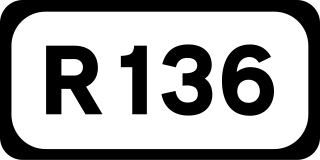
The R136 road is a regional road in Ireland, located in the southwest of Dublin. Named the Outer Ring Road, the route, which is dual carriageway, runs from the N4 at Lucan to the N81 at Tallaght, bypassing west of Clondalkin and crossing the N7 near Citywest. It was built as part of the planning for the new town of Adamstown.
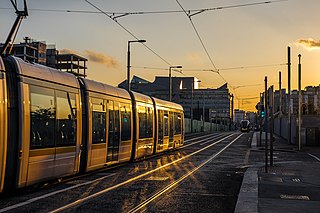
This article deals with transport in the Greater Dublin Area centred on the city of Dublin in Ireland.

Docklands Station is a terminus railway station serving the Dublin Docklands area in Ireland. It is owned and operated by Iarnród Éireann and was part of the Irish Government's Transport 21 initiative.
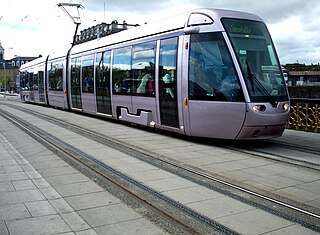
Public transport in Ireland exists in many of the Ireland's urban areas and rural areas, and takes a number of forms. Bus transport is the main form of public transport and is common in all cities. The cities, Dublin, Belfast, Cork, Limerick and Galway all have their own suburban rail networks, although Dublin is the only to have its own tram line, in the form of the Luas. Ireland has a population of 5 million people.

St Stephen's Green is a stop on the Green Line of the Luas (tram) system in Dublin, Ireland. Originally opened in 2004, it was further developed as part of the Luas Cross City project between 2013 and 2017.
Porterstown station is a proposed transport interchange intended for the Porterstown area of Dublin. As proposed, the project was intended to form an interchange between heavy rail services operated by Iarnród Éireann and light rail operations on the proposed Dublin Metro's Metro West line.
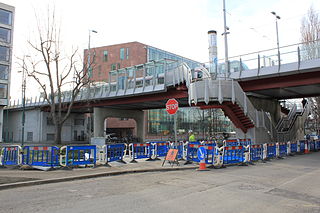
Charlemont is a stop on the Luas light-rail tram system in Dublin, Ireland. It opened in 2004 on the Green Line from St Stephen's Green to Sandyford. It provides access to parts of the south inner city, including Portobello.

Beechwood is a stop on the Luas light rail tram system in Dublin, Ireland which serves the southern parts of Ranelagh and Rathmines. It opened in 2004 as a stop on the Green Line, which re-uses the alignment of the Harcourt Street railway line which closed in 1958. Beechwood Luas stop is located on the same site as a station on the old line called Rathmines and Ranelagh, although it is lower than the original station.

















